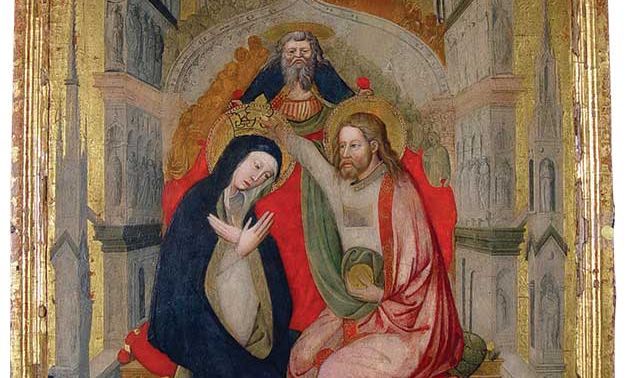Coronation of the Virgin, at Pinacoteca Nazionale in Ferrara, is undated but Maze proposes it was made by Bellini in 1441-42 Courtesy of Ministero per i Beni e le Attivita Culturali/Polo Museale dell’Emilia Romagna
What would your life have looked like if you had been born five years earlier? Ten? What would have changed, not just in your familial context but in the world around you? What were the top songs and movies five and ten years before your birth? Culture moves fast, and the context into which we are born shapes us. This is why revising an artist’s birthdate matters: it reshapes the contours of what was possible within their lifetime.
Giovanni Bellini is one of the most celebrated painters of the Italian Renaissance, but remarkably little is known about his early career. Until recently, scholars had generally supposed he was born around 1435, give or take five years on either side, and that he was the son of Jacopo Bellini, another celebrated painter and draftsman. Over 120 pages of richly illustrated text, Daniel Wallace Maze offers a thorough recontextualisation of the archival evidence related to Giovanni’s early years and convincingly argues that neither supposition is true. Rather, Bellini was likely born between mid-1424 and 13 September 1426 and he was probably the half-brother of Jacopo, who was born around 1393.
Through an attentive reading of diverse documents and Venetian legislation on inheritance, Maze shows with reasonable certainty that Giovanni was born after Jacopo’s mother had died and his father remarried. Their father, Nicoletto Bellini, died while Giovanni was very young, and his upbringing was entrusted to his half-brother, who was more than 30 years old at the time.
The reformulation of familial lineage offered in Young Bellini helps make sense of the extant documents, including Giorgio Vasari’s comment that Jacopo had been not only Giovanni’s teacher but also “like a loving father to him” (emphasis added). Why qualify a genealogical relationship in this way unless Jacopo was not Giovanni’s biological father? Beyond historical accuracy, though, what are the stakes of redefining their relationship? Maze could have more fully considered what individual style means in such a context. To what extent did Giovanni think of himself as an individual artistic agent in his early years versus part of the corporate identity of “the Bellini”, and what implications does this have for reconstructing his early “style”?
Maze’s attribution and dating of paintings highlight the difficulty of integrating the new date of birth into the corpus of Bellini’s paintings. For instance, chapter four analyses an enigmatic Coronation of the Virgin (pictured) now in Ferrara, which carries a seemingly authentic signature, but the painting is undated. The author proposes a date of 1441-42, which would mean the painting was produced by a precocious teenager. This is not impossible, but Maze’s arguments for that date are largely predicated on evidence found within other undated images used to reconstruct the chronology of the young artist.
Arguments and evidence become more technical in the volume’s two appendices. Appendix A offers a summary of the author’s argument first published in Renaissance Quarterly in 2013 and provides more detail especially related to laws of inheritance. Appendix B gives an extended analysis of “Giovanni Bellini il Vecchio” (Giovanni Bellini the Elder), a figure that has been invented by scholars who believe Bellini was born after 1435 to explain away the Giovanni Bellini described in the documents from the 1420s. Maze expertly dismantles this figment of scholarly imagination. Even so, given the book’s compact format, it seems that much of the material contained in the appendices could have been incorporated into the text to make for a more cohesive textual experience and to avoid redundancy.
Pushing Giovanni Bellini’s birthdate back by a decade is a significant revision in the history of Renaissance art. Instead of being born into a world of Alberti’s De Pictura, Bellini was born into the waning years of Gentile da Fabriano’s International Gothic. In his careful parsing of the genealogical record, Maze has laid the groundwork for a paradigm shift that scholars will continue to digest for years to come.
• Daniel Wallace Maze, Young Bellini, Yale University Press, 208pp, 117 colour illus., £25 (hb), publication 26 October 2021
• Christopher J. Nygren is associate professor of early modern art history at the University of Pittsburgh, and the author of Titian’s Icons: Tradition, Charisma, and Devotion in Renaissance Italy (Penn State Press, 2020). Throughout 2021-22, he will be Samuel H. Kress senior fellow at the Center for Advanced Study in the Visual Arts, Washington, DC

